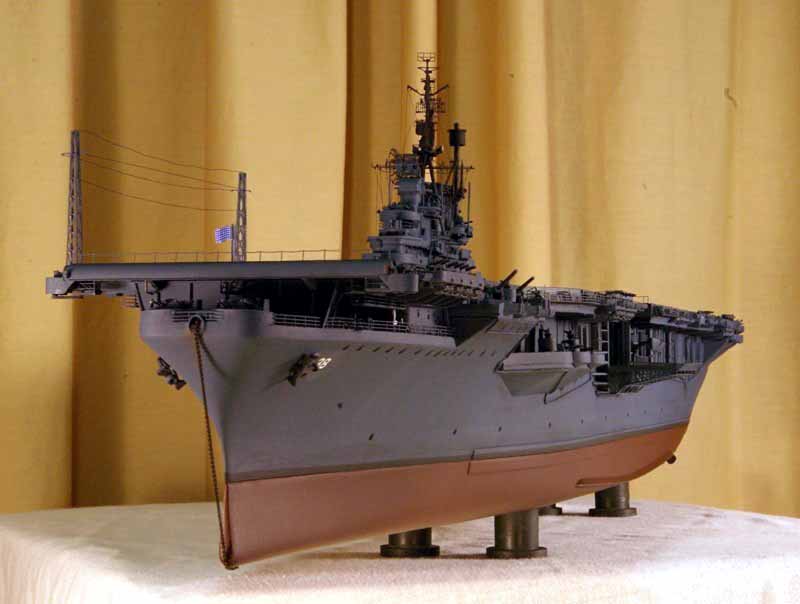by Timm Smith

1/350 USS Shangri-La CV-38 Sept.-Oct. 1945 (Trumpeter)

Here is my interpretation of the USS Shangri-la, AKA The Mystery Ship, as she appeared right after arriving back at the west coast at the end of World War II. She steamed into San Pedro Bay California and then went to San Diego to tie up. This build is my tribute to three men who served on board from Manistee County, Michigan, USA.; Louis Oscar Anderson, Chief Machinist Mate from Onekama, Michigan, Kenneth Kuenzer jr, Torpedoman's Mate from Manistee, Michigan, but especially this build is in honor of my father, Sherwood Smith, MMR/3 (Machinist Mate Refrigeration, Third Class), USNR, who served on board the Shangri-la from August 1944 through May 1946. In August ’44 he was assigned on board ship with fire watch detail as the ship was constructed. His assignment after commissioning was refrigeration systems during both normal duty and during general quarters.
This is the first model I have built since I was a kid back in the early ‘70s. I stumbled onto this web site one day in 2005 and after realizing that this modeling world existed I couldn’t wait to get started. After many, many hours of research on the internet, at local the library, and studying purchased reference material, I also found this site, ModelWarShips offering the most diverse information. The CASF thread, WIP thread, Tips and Tricks thread, and the many links to outside areas offered a great deal of information for my needs. The detailed discussions in the CASF Essex thread really taught me a lot, thanks to all for sharing. And the encouragement in the WIP thread was very nice. Many thanks to Tracy White for sharing his extensive knowledge of Essex class carriers here at Modelwarships and Researcher@Large, Steve Larsen for his inspiration from his CV-10 build, and Bob Keterhiem, historian at USS SHANGRI-LA Association web site for his wealth of information.
This build began with the Trumpeter Ticonderoga kit, with Gold Medal Models Essex and Gold Plus Essex Fine Details Photo Etch sets and lots of Evergreen polystyrene. I decided that I wanted, as much as my ability would allow, to accurately portray the Shangri-la at this specific time period. I wanted areas such as the flight deck port side overhang to show fine detail. There are very few pictures of any Essex-class ship of this area that I have seen. And looking at others' work of this area showed the greatest variations in details. What I found to be most frustrating was the lack of clear, close up photographs of any Essex class ship. Some artistic license was necessary to build all areas. Much time was spent scratch-building the various areas. From the main deck up, I worked to build areas to correspond to the pictures I have. Both the bow and stern gallery deck catwalks under the flight deck overhangs distinguish the Shangri-la from all other Essex-class sister ships. The island structure is also unique to the Shangri-La. The forward corner flight deck Mk 51 directors and tubs are unique to long hull ships. This build was a learning experience for me. I can't count how many times I re-worked scratch-built details after learning something or seeing a particular picture that I hadn't seen before. I used Gold Medal Models decals for the ship hull numbers but I think that the real hull numbers did not have black shadows lines. The flight deck markings are painted using the '38' numerals as guides for stencils. The island scoreboard is white paper printed on an ink-jet printer and white glued on.
Additional items added;
